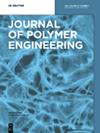Facile synthesis and electrochemical investigation of graphitic carbon nitride/manganese dioxide incorporated polypyrrole nanocomposite for high-performance energy storage applications
IF 1.7
4区 工程技术
Q4 POLYMER SCIENCE
引用次数: 0
Abstract
Manganese dioxide (MnO用于高性能储能应用的氮化石墨碳/二氧化锰与聚吡咯纳米复合材料的简便合成与电化学研究
用石墨氮化碳(GCN)和聚吡咯(Ppy)修饰二氧化锰(MnO2)纳米颗粒,以提高其电化学性能。对 Ppy/GCN/MnO2 材料的表面影响、晶体结构和电化学性能进行了表征,并与原始 MnO2 材料进行了比较。研究发现,表面改性可以在不降低 MnO2 可用比电容的情况下提高其结构稳定性。在 5 M KOH 电解液中,使用循环伏安法(CV)和交流阻抗技术评估了合成的 Ppy/GCN/MnO2 电极的电化学特性。在 5 A/g 的条件下,MnO2、Ppy/MnO2、GCN/MnO2 和 Ppy/GCN/MnO2 的比电容分别为 486、815、921 和 1377 F/g。这一改进归功于 Ppy/GCN/MnO2 电极材料中 GCN 和 Ppy 的协同效应。KOH 中的 Ppy/GCN/MnO2 电极的平均比能量和比功率密度分别为 172 Wh kg-1 和 2065 W kg-1。经过 10,000 次循环后,电容值只损失了初始值的 2%。由此产生的 Ppy/GCN/MnO2 纳米复合材料具有非常稳定的多孔分层结构。这项研究表明,Ppy/GCN/MnO2 纳米材料具有良好的结构稳定性和电化学性能,是超级电容器应用的良好材料。
本文章由计算机程序翻译,如有差异,请以英文原文为准。
求助全文
约1分钟内获得全文
求助全文
来源期刊

Journal of Polymer Engineering
工程技术-高分子科学
CiteScore
3.20
自引率
5.00%
发文量
95
审稿时长
2.5 months
期刊介绍:
Journal of Polymer Engineering publishes reviews, original basic and applied research contributions as well as recent technological developments in polymer engineering. Polymer engineering is a strongly interdisciplinary field and papers published by the journal may span areas such as polymer physics, polymer processing and engineering of polymer-based materials and their applications. The editors and the publisher are committed to high quality standards and rapid handling of the peer review and publication processes.
 求助内容:
求助内容: 应助结果提醒方式:
应助结果提醒方式:


